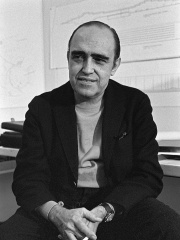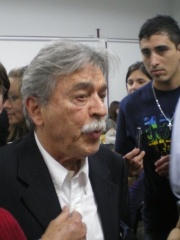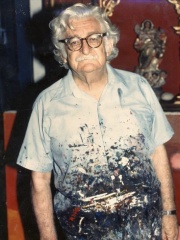


The Most Famous
ARCHITECTS from Brazil
This page contains a list of the greatest Brazilian Architects. The pantheon dataset contains 518 Architects, 3 of which were born in Brazil. This makes Brazil the birth place of the 25th most number of Architects behind Ukraine, and China.
Top 3
The following people are considered by Pantheon to be the most legendary Brazilian Architects of all time. This list of famous Brazilian Architects is sorted by HPI (Historical Popularity Index), a metric that aggregates information on a biography's online popularity.

1. Oscar Niemeyer (1907 - 2012)
With an HPI of 78.24, Oscar Niemeyer is the most famous Brazilian Architect. His biography has been translated into 84 different languages on wikipedia.
Oscar Ribeiro de Almeida Niemeyer Soares Filho (15 December 1907 – 5 December 2012), known as Oscar Niemeyer (Brazilian Portuguese: [ˈoskaʁ ni.eˈmajeʁ]), was a Brazilian architect considered to be one of the key figures in the development of modern architecture. Niemeyer was best known for his design of civic buildings for Brasília, a planned city that became Brazil's capital in 1960, as well as his collaboration with other architects on the headquarters of the United Nations in New York. His exploration of the aesthetic possibilities of reinforced concrete was highly influential in the late 20th and early 21st centuries. Both lauded and criticized for being a "sculptor of monuments", Niemeyer was hailed as a great artist and one of the greatest architects of his generation by his supporters. He said his architecture was strongly influenced by Le Corbusier, but in an interview, assured that this "didn't prevent [his] architecture from going in a different direction". Niemeyer was most famous for his use of abstract forms and curves and wrote in his memoirs: I am not attracted to straight angles or to the straight line, hard and inflexible, created by man. I am attracted to free-flowing, sensual curves. The curves that I find in the mountains of my country, in the sinuousness of its rivers, in the waves of the ocean, and on the body of the beloved woman. Curves make up the entire Universe, the curved Universe of Einstein. Niemeyer was educated at the Escola Nacional de Belas Artes at the Federal University of Rio de Janeiro, and after graduating, he worked at his father's typography house and as a draftsman for local architectural firms. In the 1930s, he interned with Lúcio Costa, with the pair collaborating on the design for the Palácio Gustavo Capanema in Rio de Janeiro. Niemeyer's first major project was a series of buildings for Pampulha, a planned suburb north of Belo Horizonte at the invitation of its mayor, Juscelino Kubitschek. His work, especially on the Church of Saint Francis of Assisi, received critical acclaim and drew international attention. Throughout the 1940s and 1950s, Niemeyer became one of Brazil's most prolific architects, working both domestically and overseas. This included the design of the Edifício Copan (a large residential building in São Paulo) and a collaboration with Le Corbusier (and others) on the United Nations Headquarters, which yielded invitations to teach at Yale University and the Harvard Graduate School of Design. In 1956, Niemeyer was invited by Brazil's new president, Juscelino Kubitschek, to design the civic buildings for Brazil's new capital, Brasília. His designs for the National Congress of Brazil, the Cathedral of Brasília, the Palácio da Alvorada, the Palácio do Planalto, and the Supreme Federal Court, all designed by 1960, were experimental and linked by common design elements. This work led to his appointment as inaugural head of architecture at the University of Brasília, as well as honorary membership of the American Institute of Architects. Due to his largely left-wing ideology and involvement with the Brazilian Communist Party (PCB), Niemeyer left the country after the 1964 military coup and opened an office in Paris. He returned to Brazil in 1985, and was awarded the prestigious Pritzker Architecture Prize in 1988. A socialist and atheist from an early age, Niemeyer had spent time in both Cuba and the Soviet Union during his exile, and on his return served as the PCB's president from 1992 to 1996. Niemeyer continued working at the end of the 20th and early 21st century, notably designing the Niterói Contemporary Art Museum (1996) and the Oscar Niemeyer Museum (2002). Over a career of 78 years he designed approximately 600 projects. Niemeyer died in Rio de Janeiro on 5 December 2012 at the age of 104.

2. Paulo Mendes da Rocha (1928 - 2021)
With an HPI of 65.84, Paulo Mendes da Rocha is the 2nd most famous Brazilian Architect. His biography has been translated into 35 different languages.
Paulo Mendes da Rocha (October 25, 1928 – May 23, 2021) was a Brazilian architect. Mendes da Rocha attended the Mackenzie Presbyterian University College of Architecture, graduating in 1954. Working almost exclusively in Brazil, Mendes da Rocha began designing buildings in 1957, many of them built in concrete, a method some call "Brazilian Brutalism", arguably allowing buildings to be constructed cheaply and quickly. He contributed many notable cultural buildings to São Paulo and is widely credited with having enhanced and revitalized the city. Mendes da Rocha was a professor at the Architecture College of University of São Paulo, known as FAU-USP, until 1998. His work was influenced by Brazilian architect Vilanova Artigas, from the paulist Brazilian School. He was honored with the Mies van der Rohe Prize (2000), the Pritzker Prize (2006), and the Venice Biennale Golden Lion for lifetime achievement (2016). Mendes da Rocha died on May 23, 2021, in São Paulo at the age of 92.

3. Roberto Burle Marx (1909 - 1994)
With an HPI of 62.71, Roberto Burle Marx is the 3rd most famous Brazilian Architect. His biography has been translated into 22 different languages.
Roberto Burle Marx (August 4, 1909 – June 4, 1994) was a Brazilian landscape architect (as well as a painter, print maker, ecologist, naturalist, artist and musician) whose designs of parks and gardens made him world-famous. He is credited with having introduced modernist landscape architecture to Brazil. He was known as a modern nature artist and a public urban space designer. His work had a great influence on tropical garden design in the 20th century. Water gardens were a popular theme in his work. He was deftly able to transfer traditional artistic expressions such as graphic design, tapestry and folk art into his landscape designs. He also designed fabrics, jewellery and stage sets. He was one of the first people to call for the conservation of Brazil's rainforests. More than 50 plants bear his name. He amassed a substantial collection of plants at his home, including more than 500 philodendrons, including some that were discovered by him or bear his name, like Philodendron burle-marxii.
People
Pantheon has 3 people classified as Brazilian architects born between 1907 and 1928. Of these 3, none of them are still alive today. The most famous deceased Brazilian architects include Oscar Niemeyer, Paulo Mendes da Rocha, and Roberto Burle Marx.
Deceased Brazilian Architects
Go to all RankingsOscar Niemeyer
1907 - 2012
HPI: 78.24
Paulo Mendes da Rocha
1928 - 2021
HPI: 65.84
Roberto Burle Marx
1909 - 1994
HPI: 62.71
Overlapping Lives
Which Architects were alive at the same time? This visualization shows the lifespans of the 3 most globally memorable Architects since 1700.

